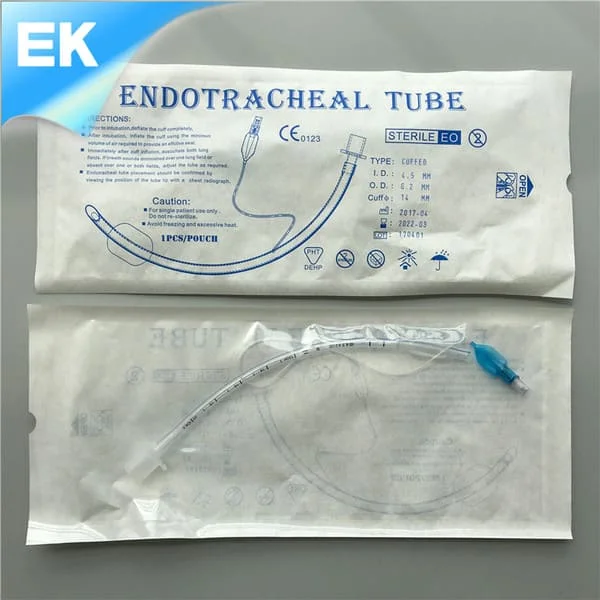Role of endotracheal tube
Emergency endotracheal tube technique has become an important measure in the resuscitation of patients with cardiopulmonary resuscitation and acute and critical illnesses with respiratory dysfunction. endotracheal tube is an important resuscitation technique commonly used in emergency work, and it is one of the most widely used, effective and quickest means of airway management. It is a basic skill that must be mastered by medical personnel, and it plays a vital role in saving patients' lives and reducing the mortality rate. It also enables timely suctioning of endoendotracheal secretions or foreign bodies, preventing foreign bodies from entering the airway, keeping the airway unobstructed, providing effective manual or mechanical ventilation, and preventing patients from hypoxia and carbon dioxide retention.
Endotracheal tube care
Although endotracheal tube is more often used in respiratory and cardiac arrest resuscitation, it is difficult to fix the endotracheal tube, and most patients may be prematurely extubated and withdrawn due to irritability or intolerance in the early stage of recovery of consciousness. So, in order to avoid extubation and withdrawal, what should be the postoperative care?
1.Fixation of endotracheal tube
Soft endotracheal tube should be fixed together with hard dental pads, and can be fixed with adhesive tape and inch tape to prevent displacement or dislocation. The inch band should not be fixed too tightly to prevent deformation of the lumen, and the scale of the endotracheal cannula and in front of the incisor should be measured regularly and recorded. The patient's hands should be restrained with a restraint band to prevent damage to the pharynx when the patient wakes up or withdraws the tube on his own when there are psychiatric symptoms. Change the dental pad and adhesive tape daily, and provide oral care.
2.Keep the endotracheal tube unobstructed
Aspirate oral and endotracheal secretions in a timely manner, pay attention to aseptic operation when aspirating sputum, and strictly separate oral and endotracheal aspiration tubes. The sputum suction tube and oxygen suction tube should not exceed 1/2 of the inner diameter of the endotracheal tube to avoid blocking the airway. Do one tube and one glove at a time for each suction, and keep the suction tube in the airway for less than 15 seconds.
3.Keep the airway moist
The oxygen concentration should not be too large, generally 1-2 liters/minute, and the oxygen needle should be inserted halfway into the endotracheal tube. When the sputum is sticky, nebulized inhalation once every 4 hours, or drip wetting solution into the trachea, 2 -5ml each time, not more than 250ml in 24h.
4.Keep track of the position of endotracheal tube
The position and depth of the catheter can be understood by listening to the breath sounds of both lungs or by X-ray. If the breath sound is lost on one side, the trachea may be inserted into one lung and needs to be adjusted in time.
5.The air bag is suitable for loosening and tightening
Deflate the airbag once every 4 hours for 5-10 minutes and aspirate the secretions in the oropharynx and trachea before deflation. Tracheotomy should be considered after 72h of retention of the endotracheal tube to prevent prolonged compression of the endotracheal mucosa by the balloon, which may cause mucosal ischemia and necrosis.
6.Extraction procedure.
(1) Indications for extubation: The patient should be extubated when he/she is clear, his/her vital signs are stable, his/her choking reflex is restored, his/her coughing sputum is strong and his/her muscle tone is good.
(2) Explain to the patient well before extubation and prepare oxygen mask or nasal cannula.
(3) Suck out oral secretions, suction sputum fully in the trachea, and administer oxygen for one minute with a breathing bag under pressure.
(4) Release the inch tape and adhesive tape fixing the endotracheal tube, place the suction tube at the deepest part of the endotracheal tube, suction sputum while extubating, and administer oxygen by mask immediately after extubation.
7.After extubation care.
(1) Observe whether the patient has clinical manifestations of hypoxia and respiratory difficulty such as nasal flapping, shallow breathing, cyanosis of lips and nails, and rapid heart rate.
(2) Prepare tracheotomy kit at the bedside. If severe laryngeal edema is not relieved by 20 minutes of nebulized inhalation or 5 mg of dexamethasone, tracheotomy should be performed immediately.
Related News




